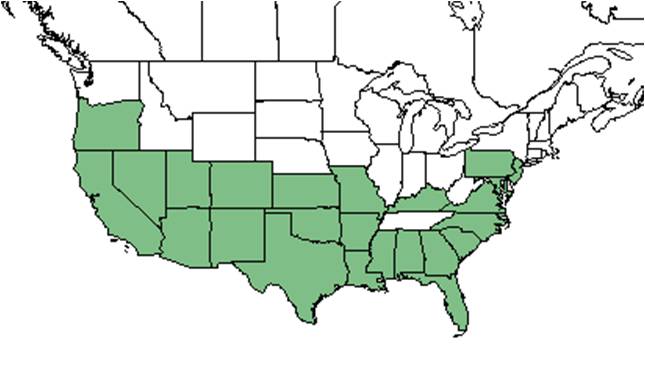Difference between revisions of "Phyla nodiflora"
KatieMccoy (talk | contribs) |
KatieMccoy (talk | contribs) |
||
| Line 26: | Line 26: | ||
==Ecology== | ==Ecology== | ||
===Habitat=== <!--Natural communities, human disturbed habitats, topography, hydrology, soils, light, fire regime requirements for removal of competition, etc.--> | ===Habitat=== <!--Natural communities, human disturbed habitats, topography, hydrology, soils, light, fire regime requirements for removal of competition, etc.--> | ||
| + | In the Coastal Plain in Florida, ''P. nodiflora'' has been observed growing in roadside hydric seepage bogs and exposed limerock (FSU Herbarium). Associated species include ''Bidens, Polygonum, Cyperus'' and ''Ludwigia'' (FSU Herbarium). | ||
| + | |||
===Phenology=== <!--Timing off flowering, fruiting, seed dispersal, and environmental triggers. Cite PanFlora website if appropriate: http://www.gilnelson.com/PanFlora/ --> | ===Phenology=== <!--Timing off flowering, fruiting, seed dispersal, and environmental triggers. Cite PanFlora website if appropriate: http://www.gilnelson.com/PanFlora/ --> | ||
===Seed dispersal=== | ===Seed dispersal=== | ||
Revision as of 10:21, 12 November 2015
| Phyla nodiflora | |
|---|---|

| |
| Scientific classification | |
| Kingdom: | Plantae |
| Division: | Magnoliophyta - Flowering plants |
| Class: | Magnoliopsida – Dicotyledons |
| Order: | Lamiales |
| Family: | Verbenaceae |
| Genus: | Phyla |
| Species: | P. nodiflora |
| Binomial name | |
| Phyla nodiflora (L.) Greene | |

| |
| Natural range of Phyla nodiflora from USDA NRCS Plants Database. | |
Common name: turkey tangle fogfruit
Contents
Taxonomic notes
Description
Distribution
Ecology
Habitat
In the Coastal Plain in Florida, P. nodiflora has been observed growing in roadside hydric seepage bogs and exposed limerock (FSU Herbarium). Associated species include Bidens, Polygonum, Cyperus and Ludwigia (FSU Herbarium).
Phenology
Seed dispersal
Seed bank and germination
Fire ecology
Pollination
The following Hymenoptera families and species were observed visiting flowers of Phyla nodiflora at Archbold Biological Station (Deyrup 2015):
Apidae: Apis mellifera
Halictidae: Augochloropsis metallica, Halictus poeyi, Lasioglossum lepidii
Megachilidae: Anthidium maculifrons, Coelioxys mexicana, C. texana, Megachile brevis pseudobrevis, M. mendica
Sphecidae: Ammophila urnaria, Bicyrtes insidiatrix, Prionyx thomae
Use by animals
Diseases and parasites
Conservation and Management
Cultivation and restoration
Photo Gallery
References and notes
Deyrup, M.A. and N.D. 2015. Database of observations of Hymenoptera visitations to flowers of plants on Archbold Biological Station, Florida, USA.